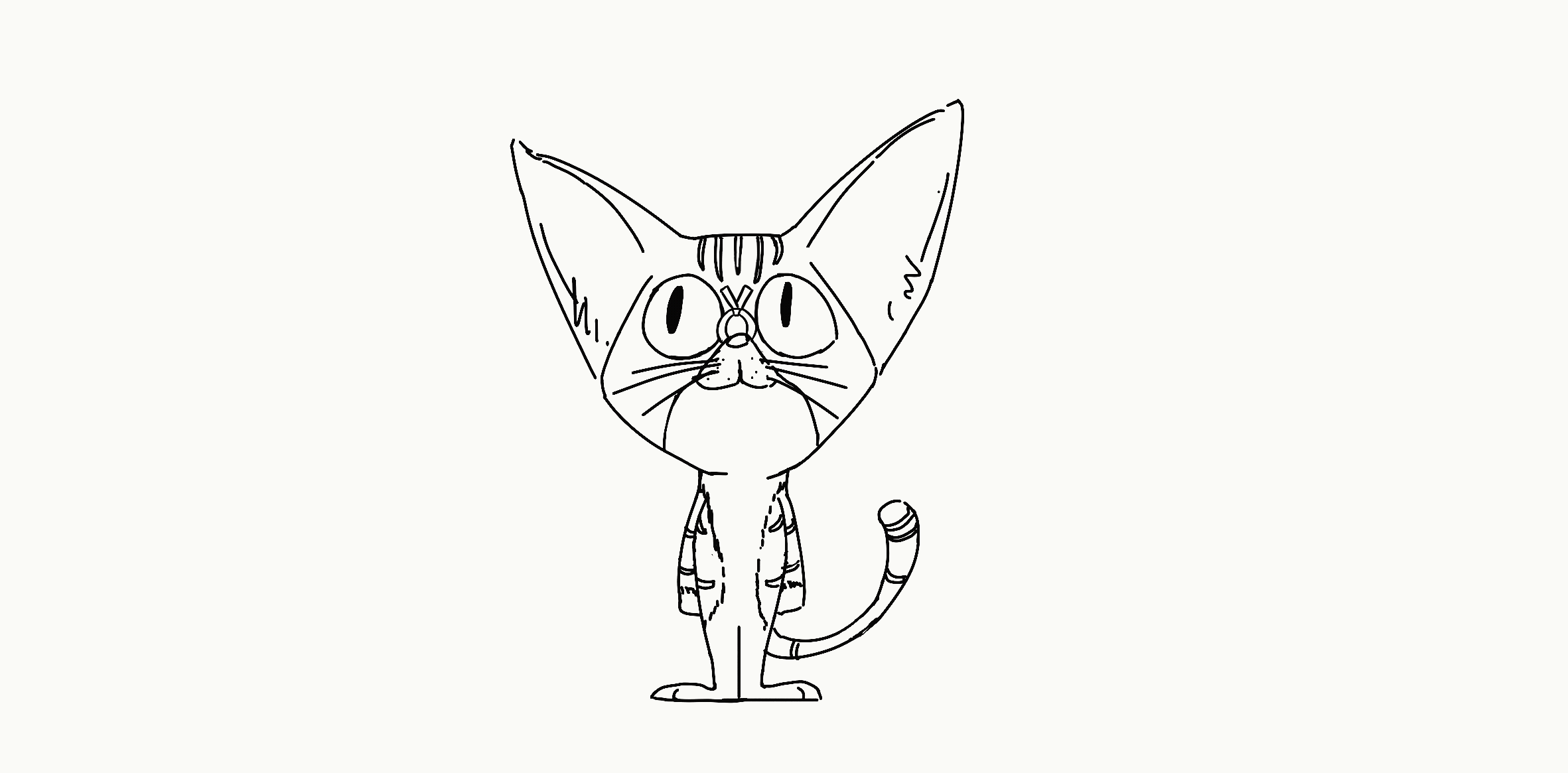GERILE YANG
STORY ARTIST & SOCIAL INNOVATOR

Introduction
In the Smoke Screen Project, our team aimed to address significant social issues through innovative communication strategies. Conducted as part of a sponsored class called Igniting Local Change: LGBTQ+ Advocacy for Health Justice, sponsored by the Cedars-Sinai Center for Health Equity, we focused on developing campaign designs targeting QTPOC community members who are in college and live in multi-unit housing, facing issues related to secondhand or thirdhand smoke. Additionally, this campaign sought to raise awareness about the misinformation and misrepresentation of LGBTQ+ community members in mainstream media. This project highlighted the power of teamwork and creative problem-solving in advocating for health justice and supporting marginalized communities.
My role
Design strategist
IP character designer
Story Artist
The team
Isaac Tseng, Design strategist &Interaction designer
Kat Shirinyan, Design strategist &Graphic designer
Joshua Halstead, Instructor
Leigh Hoffman, Instructor
Cedars-Sinai Center for Health Equity team


Process Overview
The following content outlines the process we underwent to deliver the final designs. This process was divided into two main phases: research and design. Through a combination of secondary and primary research, we gained a deeper understanding of the issues surrounding the LGBTQ+ community, tobacco use, and media representation. Utilizing both qualitative and quantitative data collection methods, we derived key insights that informed our final designs.
Mind Mapping
We began by brainstorming in class after receiving presentations from the Cedars-Sinai Center for Health Equity team. From their presentations, we gained valuable insights into their service emphasis, target audience, and the specific problems they aim to address. This provided us with a foundational understanding to get started on the project. -- Brainstorming view
After returning to our group work, we created a mind map centered on the major themes that interested us. Next, we explored the interconnections among these themes, identifying points where tobacco products might enter and influence members of the LGBTQ+ community. From this analysis, we identified several potential problem spaces and selected three areas that we were particularly interested in exploring further.
-
The interconnection between peer pressure, yearning for community & tobacco use.
-
The power dynamic between big-money tobacco companies and LGBTQ+ communities’ yearning for visibility.
-
Targeting unique tobacco experiences among smaller communities & building a stronger sense of specificity in anti-tobacco campaigns.

Major Themes
Interconnections
Tobacco Entry Points
Problem Spaces
Problem Spaces selected
Secondary Research
To gain more in-depth knowledge in the field, we reviewed scholarly articles, official websites, documentaries, local government reports, and a variety of other resources. Here are some highlights and insights we discovered:
-
Hate crimes on upswing compared to 2022.
“Out of 39 hate crime incidents reported in Long Beach the past two and a half years, the most frequently targeted groups were LGBT people (13 incidents) and Black people (11 incidents), according to city data.” LGBTQ+ youth are common targets, they actively seek out community to find strength in numbers or safe haven.
Long Beach Post News, Jul 13, 2023 - Source
-
“Long Beach is located in one of the wealthiest counties (Los Angeles), in one of the wealthiest nations in the world, yet 22.8% of our residents live at or below the U.S. Federal Poverty Guidelines. That’s significantly higher than the national rate of 15.1%.”
Long Beach Community Action Partnership, 2023 - Source
-
Several LGBTQ+ tolerant spaces are promoted on Visit Gay Long Beach. However, truly dedicated spaces for LGBTQ+ people to find safety or crisis help are very limited.
High concentrations of Tobacco are sold near schools, where many gender-diverse youth of color are located. Although cigarette sales have declined, other flavored tobacco products have shown growth in sales.
Healthy Stores for a Healthy Community - Source
-
49% of movies showed LGBT leading or supporting characters using tobacco products while only 3 of every 20 movies showed a negative consequence of tobacco use.
Out smoking on the big screen: Tobacco use in LGBT movies, 2000–2011 - Source
Problem Statement
According to the insights we got from research and the three problem spaces we are interested in, we came up with our problem statement which is tobacco companies have exploited the queer community’s desire for visibility, and capitalized on peer pressure in queer spaces to promote their products. Then we frame it in the "How might we..." frame.
How might we dismantle the notion that fitting in is the only way to integrate into queer spaces and find acceptance?
How might we identify the signs and stages of big-money tobacco exploitation in queer youth and create interventions?
How might we design a way to empower all voices to get involved in advocacy, no matter how quiet or loud they are?
Personas
Based on the key insights, we created three personas to provide a clearer preview of our audience and to aid in developing more effective design ideas.




Design Focus
We conducted additional secondary research and decided to focus on film and media to find a solution from that perspective. Tobacco is both a cultural & health epidemic. We are consuming 3rd-hand smoke through our screens.
-
Film & media are highly influential in the spread of popular culture to young people in colleges.
Particularly learned behavior.
-
Half of the movies released in recent years feature a queer lead character using tobacco.
Primarily in a positive image.
-
Netflix shows more than twice as many scenes involving tobacco than its rivals & traditional TV.
Mostly in shows targeting viewers age 15-24
3rd hand smoke from screen

But I’m a Cheerleader– 1999

A Single Man – 2009

Euphoria – 2019 to 2022

Call Me By Your Name – 2017
Research Summary
A brief review and summary of the research session, highlighting the key insights we gathered and outlining what we plan to carry forward into the design session.
-
Target market: QTPOC (Queer Trans People of Color) College Students
-
Location: Colleges in Long Beach, CA
-
Major factors in tobacco adoption: Age of Self-Discovery, Film + Media, Life pressures & Stresses, Peer Influence.
-
Target Impacts: Equip QTPOC college students with the tools to begin identifying manipulative tobacco depictions in media.
Minimize the impact tobacco companies have on the construction of values and self-perception among queer youth.
Encourage QTPOC college students to use peer influence in a positive light to fight against tobacco’s spread.
Concept direction & mood board
At the beginning of the design session, we brainstormed the essential elements and determined the style and visuals of our campaign together. We ultimately adopted the 1940s American TV animation style for our final style guide.

Then, based on our team members' skill sets, we divided the tasks individually.
-
My role: Animation& IP character
Design the IP characters and produce an animatic storyboard to illustrate the challenges faced by QTPOC college students and raise awareness about misrepresentation on the big screen.
-
Web-distribution:
Design a website that teaches youth how to identify implicit tobacco messaging in film/television, and how to get involved in the campaign.
-
Campaign System:
Targeting tobacco depiction in film/media. Using humor as a way to connect with college students and create advocacy posters.
Sketches
Here is the first version of the character sketches and storyboard thumbnails I delivered. Some thinking process when I'm designing.

-
What does 1940s American TV animation style look like? what were the characteristics of the design at that time?
One of the defining characteristics of character design from that era is its highly graphic nature, consisting of basic geometric shapes. The proportions and actions of the characters are often exaggerated and personified.
-
What's the personality of the character?
The personalities of the characters are determined by the story, and in turn, they also shape the storytelling. Therefore, this is an essential part of the design session. I experimented with various types of cat designs to provide more possibilities for discussion with my teammates and our audience.

-
What style of animation could fit in the style of the campaign?
Since the main style is 1940s American TV animation, I studied the characteristics of that era. First, I found that the frame ratio commonly used was 4:3 (1.33). Additionally, the camera movement in TV animation from that time was very subtle, with most of the stories being conveyed through the characters' performances due to budget considerations.
-
What story do I want to create to show the issues people are facing? What emotion do I want to create and how will people react after showing the boards?
The main character of the story is a cat, who shares happy and relaxed moments with their owner, a QTPOC member. Their interactions are filled with warmth and humor. However, beneath this light- hearted atmosphere, there lies a hint of danger from second-hand and third-hand smoke, as well as the "smoke" emanating from the screen.
Interview
Since the project is sponsored by Cedars-Sinai, we had the opportunity to receive direct feedback from our audience about our design. Most of the interviewers either live in the LGBTQ+ community or have worked with their members before. Sharing and discussing our campaign plan and work process with them has been incredibly valuable, helping us as designers to understand different perspectives and adjust our design for better clarity and accessibility.
During the interviews, we took turns performing different roles. I served as the listener and note-taker. After collecting all the feedback, we organized our notes and created an affinity map to gather and analyze the insights. Here are the key insights we got from it.

-
Tobacco smoke in multi-unit housing is a common experience.
-
A cat character is an effective subject to draw on emotions to capture audiences.
-
The cat owner needs some sort of reaction to the smoke too to paint a more relatable picture.
-
It is much easier to encourage being considerate through the humorous lens of an annoyed cat than an annoyed human.
-
Minimal use of the rainbow is great for avoiding a stereotypical tone of the campaign.
-
Realtime updates are very important for participant retention.
-
QTPOC substance use depiction is disproportionately prevalent in mainstream media.
All Designs
Here are all the deliverables we created for the smoke screen campaign as a whole team.

Gerile Yang



Isaac Tseng


If you want to know more details about the project, you can go here.